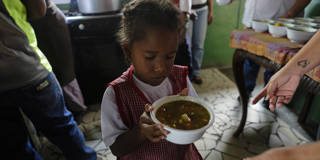Additional investments in early childhood nutrition are crucial, and should be a high priority for donor and recipient governments, multilateral development organizations, and philanthropic foundations. The case for such spending is clear, and the payoffs will almost certainly be enormous.
EDINBURGH – It’s easy to think of starvation as a challenge that entered the rich world’s consciousness in the 1980s and was largely solved through charity rock concerts. True, the world has made huge progress in combating mass starvation over the past 30 years, largely as a result of improved agricultural practices. Yet, globally, food deprivation still claims a child’s life every three seconds.
A new report from the United Nations warns that the number of hungry people worldwide increased for a third consecutive year in 2018, and now exceeds 820 million. And some two billion people – over one-quarter of the world’s population – lack regular access to safe, nutritious, and sufficient food.
These quiet deaths and silent suffering don’t seize the world’s attention like past famines did. But they should. Although we have made progress against hunger, there is a powerful case to do even more. In particular, improving child nutrition is one of the most transformative investments that governments and donors can make. Research by the Copenhagen Consensus Center think tank shows that each dollar spent on nutrition in the first 1,000 days of a child’s life returns $45 to society by ensuring that he or she has a healthier and more prosperous future.

EDINBURGH – It’s easy to think of starvation as a challenge that entered the rich world’s consciousness in the 1980s and was largely solved through charity rock concerts. True, the world has made huge progress in combating mass starvation over the past 30 years, largely as a result of improved agricultural practices. Yet, globally, food deprivation still claims a child’s life every three seconds.
A new report from the United Nations warns that the number of hungry people worldwide increased for a third consecutive year in 2018, and now exceeds 820 million. And some two billion people – over one-quarter of the world’s population – lack regular access to safe, nutritious, and sufficient food.
These quiet deaths and silent suffering don’t seize the world’s attention like past famines did. But they should. Although we have made progress against hunger, there is a powerful case to do even more. In particular, improving child nutrition is one of the most transformative investments that governments and donors can make. Research by the Copenhagen Consensus Center think tank shows that each dollar spent on nutrition in the first 1,000 days of a child’s life returns $45 to society by ensuring that he or she has a healthier and more prosperous future.